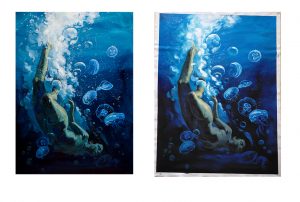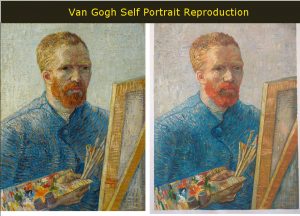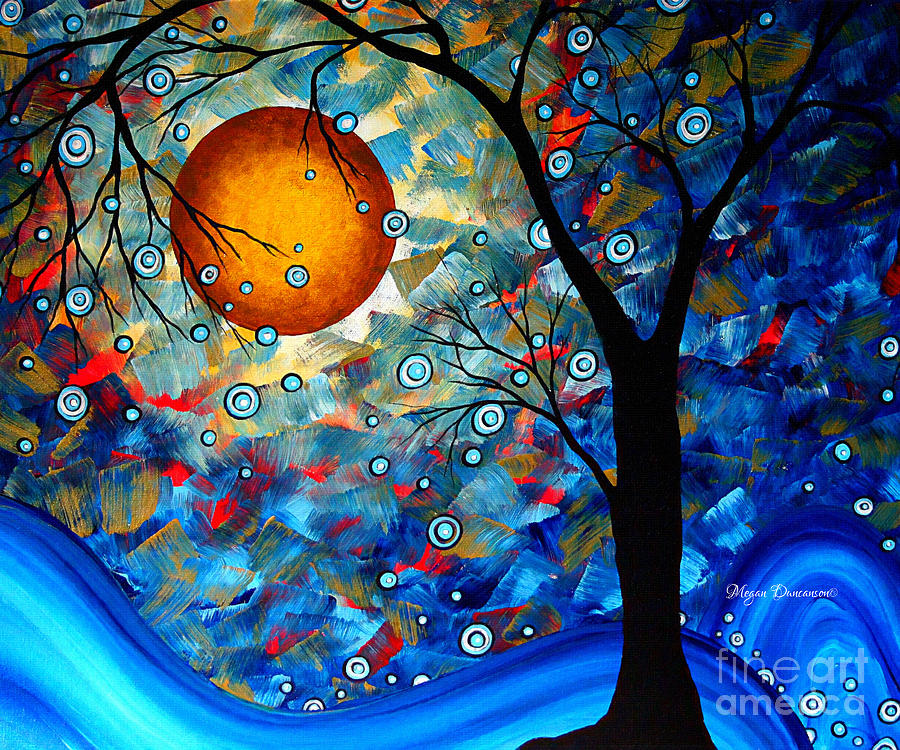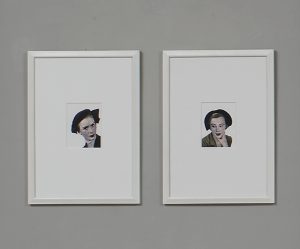La sculpture a connu depuis quelques decennies bien des eclatements. Malgre ces nombreuses ruptures, elle a toujours conserve sa nature anthropomorphique que ce soit sur le plan structural ou conceptuel. Par contre, elle a pratiquement evacue la figure humaine de son registre formel. Defiant pour ainsi dire cette convention, Balkenhol renverse la situation. Mais ce revirement ne signifie pas pour autant une attitude reactionnaire pronant simplement le retour a la tradition, a la figuration et au realisme. Heritier du minimalisme par l’enseignement d’Ulrich Ruckriem et conscient de l’histoire des formes, il reconcilie l’ancien et le nouveau dans un travail de synthese habite par la reflexion mais rehabilitant le plaisir, trop souvent absent dans l’art contemporain. Car Balkenhol s’amuse avec l’histoire tout en questionnant les fondements memes de la sculpture. Il puise dans le repertoire de la statuaire, notamment de l’epoque medievale, des modeles qu’il transpose dans un monde actuel en les adaptant a son style bien personnel qui consiste a rendre les sujets ordinaires et impersonnels. Mais en les rendant plus semblables a l’homme contemporain, il les banalise. Homme portant sa tete sous le bras (1994) en est un exemple frappant. Inspiree d’une sculpture gothique representant un saint martyr tenant sa tete dans ses mains, cette oeuvre nous montre un homme debout sur un socle en forme de tabouret, vetu d’une chemise blanche et d’un pantalon noir, tenant sa tete sous le bras, comme s’il s’agissait d’une scene banale. La banalisation, chez Balkenhol, n’est toutefois jamais ironique. Elle vise plutot a redonner un statut democratique a la sculpture qui, autrefois, occupait essentiellement la place publique. D’ailleurs, Balkenhol a realise plusieurs oeuvres publiques reprenant sensiblement les memes sujets masculins, anodins, inactifs et inexpressifs. Ils sont toujours de meme format, soit un peu plus petit que grandeur nature, et leur emplacement dans la ville a souvent de quoi surprendre, places sur une bouee ou a meme un mur de maconnerie a une distance ou une hauteur qui laisse croire que le personnage est reel et dans une mauvaise posture. Parmi ses sculptures publiques, se trouve aussi une statue equestre, situee dans un parc a Hambourg, qui n’a conserve de l’histoire classique que le theme car elle n’a rien en commun avec la monumentalite et la noblesse des cavaliers celebres, vestiges de la Rome antique. La contrefacon ne s’arrete pas la. Balkenhol a aussi recupere, avec humour, un cliche de la sculpture moderne, le fameux Penseur de Rodin, qui devient sous la gouge de l’artiste l’Homme assis (1990), un personnage au torse nu portant le legendaire pantalon noir qu’on retrouve dans prasque toutes ses oeuvres ou figure un personnage masculin.
L’art contemporain nous a entraines a percevoir le travail tridimensionnel comme un systeme additif dans un esprit plus ou moins dadaiste ou constructiviste. Il nous a aussi habitues au conflit, au drame ou a la complexite symbolique. Balkenhol brise a nouveau ces preceptes en taillant, tel un artisan, des sculptures polychromes et monoxyles presque trop limpides ou le conflit est absent. Il n’y a pas de rapport de force entre les protagonistes, entre l’homme et l’animal dans les pieces telles Homme aux lions, Homme au taureau, Petit homme aux deux crocodiles (1994), pour n’en nommer que quelquesunes, ou figure un petit homme avec des animaux de taille similaire. Il n’y a pas de domination mais une complicite immediate, une confiance mutuelle qui conduit au jeu et a l’univers fantasmagorique de l’enfance ou toutes les associations deviennent possibles, meme ces tetes de vache, lion, aigle sur des corps d’hommes de toute evidence <<civilises>>. Avec Trois bybrides (1995), Balkenhol est plus pres d’un La Fontaine que d’un Ovide, plus pres du conte populaire que du surrealisme.
L’aspect schematique des personnages de Balkenhol et leur simplicite caracterielle sont d’une familiarite enfantine. L’Homme au maillot de bain noir (1993) et la Femme au maillot de bain vert (1993) sont tellement personne en particulier qu’ils deviennent uniquement des representants sociaux de l’homme et de la femme adultes, les <<Paul et Marie>> de nos livres scolaires. Cet interet pour la periode scolaire est particulierement manifeste dans Seize dessins au tableau noir (1994), dont quelques-uns ont donne naissance a la serie des petits hommes avec animaux. Ces oeuvres representent des dessins a la craie blanche executes sur un tableau noir. Cette allusion a l’ecole n’est pas nouvelle, en 1990 l’artiste avait presente en Belgique une exposition ou le dessin prenait une place considerable et la couverture du catalogue imitait un cahier de composition d’ecolier allemand.
La facture des oeuvres, conjuguee aux antecedents culturels de l’artiste, pourrait laisser croire a une filiation avec l’expressionnisme allemand. Ses portraits sculptes en creux dans des planches de bois evoquent un certain primitivisme que les expressionnistes revendiquaient en valorisant la gravure sur bois propre a la culture germanique. Mais, contrairement a ceux-ci, la marque brute et rapide du ciseau ne procure aucune expression aux objets. Paradoxalement, elle ne laisse paraitre aucune emotion, que de la neutralite. Balkenhol n’est pas non plus un sculpteur naturaliste. Ses personnages, entiers ou partiels, ne sont pas des portraits dans le sens noble du terme et les animaux sont isoles de leur contexte naturel. Habitue d’inventer des histoires, le spectateur croira voir une banquise dans Cinquante-sept manchots (1991) alors qu’il s’agit en fait d’un groupe de pingouins sculptes individuellement a meme la colonne de bois qui preside a la forme et dont la partie non touchee fait office de socle. La figuration est bien un leurre, car le spectateur traversant cette installation apparemment illusionniste sera confronte a un ensemble de colonnes carrees dont la hauteur et la disposition imposent une presence, amusante et intimidante a la fois. Les proportions de la salle rectangulaire et etroite qui accueille cette oeuvre contribuent a augmenter l’effet de cette rencontre inusitee entre le spectateur et l’objet, obligeant le premier a prendre conscience de son corps et de sa presence dans cet espace occupe par les colonnespingouins. On retrouve bien la, dans cette oeuvre, la dimension minimaliste heritee de Ruckriem. Car ce n’est ni l’individu ni le heros qui preoccupe Balkenhol mais la presence immediate imposee par le caractere affirmatif des structures et des corps anonymes.
Dans le travail de Balkenhol, le prototype l’emporte sur la personnification et la repetition du modele l’emporte sur l’unicite qui caracterise le genre humain. Ces individus ne sont plus que des representants de l’etre culturel dont la posture, les traits et les vetements trahissent l’archetype occidental. En ce sens, l’oeuvre rappelle l’anonymat et la depersonnalisation largement exploites dans les annees soixante par les artistes du Pop Art. Toutefois, on ne trouve pas chez Balkenhol la connotation critique propre aux premiers. L’anonymat contribue plutot a detourner l’attention du spectateur qui, faute de pouvoir trouver un sens a une narration volontairement eliminee, doit considerer la sculpture pour ce qu’elle est, c’est-a-dire une structure dans l’espace qui interpelle le spectateur.
Meme si, a premiere vue, les oeuvres de Balkenhol semblent raconter des histoires, l’artiste se defend bien de faire de la sculpture anecdotique. A la limite elles sont des declencheurs de recits mais ceux-ci restent ouverts a toute interpretation. Ce qui interesse Balkenhol c’est d’abord le volume, le materiau et la presence, caracteristiques tout a fait minimalistes auxquelles il ajoute une bonne dose d’humour.





